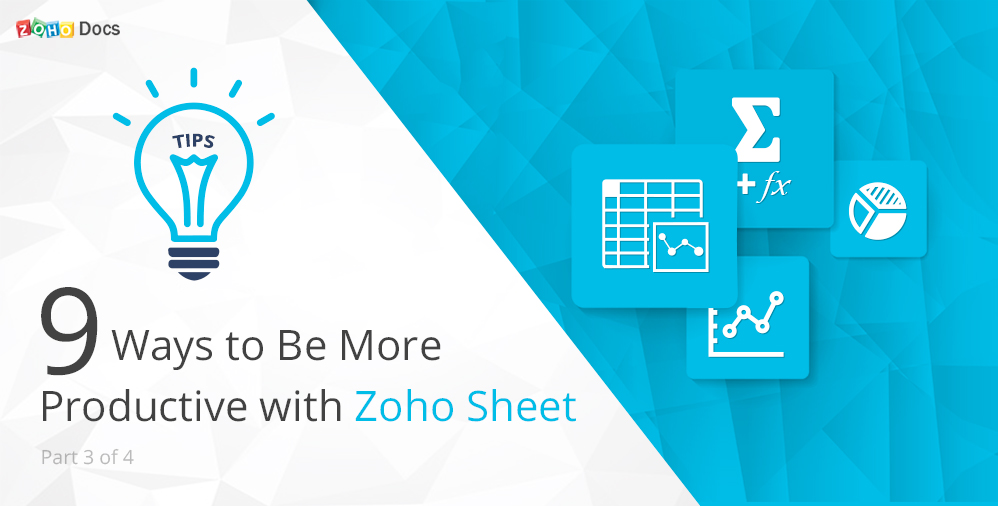We started the series with the productivity tips from our online document management solution – Zoho Docs followed by Zoho Writer. Today, we will master our next online editor – Zoho Sheet.
Zoho Sheet is an online spreadsheet application that helps you organize your data, and analyze them while collaborating with your team online. While working with your numbers in Zoho Sheet can be a breeze, we have a few tips and tricks below which can help you get the best out of it.
1. Chat with your collaborators
Five people are editing a spreadsheet, including you. You want to inform other collaborators to add more information to a specific field for you to proceed with your data. What do you do? Call them? Mail them? Or switch to your Office Communicator? You need none of these options. The easiest solution — interact with your collaborators using the built-in chat application and engage with them to finish tasks faster.
2. Using Paste Special
Imagine you have a financial spreadsheet full of comments and formulas. You would just like to copy and paste specific formulas and comments elsewhere. You can use Paste Special option in such cases.
Paste Special lets you copy formats, formulas, comments and a few other options individually or the values present in the respective cells without them. It can be accessed from the context menu. Make use of it when you find a complicated spreadsheet.
3. Copy Formatting
Format Painter is a niche tool that can be used to format individual cells. If you want to copy the formatting of a specific cell to other cells, choose the cell whose formatting you want to copy, click the Format Painter icon and click or select the range on which you would like to apply the same formatting.
If you double click the Format Painter icon, you can keep copying the formatting settings as long as you want for multiple times. To stop using the tool from this mode, just press Escape.
4. Repeat Last Action
Who doesn’t love doing less to gain more? That’s exactly what this tip will help you do. Instead of performing the same actions repeatedly, you can use simple keyboard shortcuts to repeat your last action. Press Command + Y keys on Mac and Ctrl + Y on Windows to repeat any action that your performed last on a different range of cells to achieve the same result. You can also use the shortcut F4 to repeat the last action you had performed.
5. Find Your Stats Instantly
If you like your statistics to be served on your table, select the range and from the bottom right corner of your page, choose from Sum, Average and Total Count to get instant results.
6. Name Your Ranges
When you are entering the cell ranges in formulas, which seems like an easier choice; C2:C20 + D2:D20 or July_Sales + August_Sales ? Of course the latter. Typing cell ranges in formulas can not only be confusing and tricky, but also tiresome. Instead, define names for the cell ranges, which are easy to remember, from the Formulas tab and make your work much less cumbersome!
7. Insert Multiple Rows/Columns
You have already created a table with all the data in place. But suddenly, you realize you missed out adding some data. You can do this without disturbing the other cells by adding rows and columns wherever needed. Just select the total number of rows that you would like to insert. Right click the rows and click “Insert Row Above” or “Insert Row Below” according to your need. Follow the same procedure for columns. Now add the data in these rows/columns.
8. Transpose Rows/Columns
Many times, after working for a while, you may decide you rather have the current set of rows running across the columns. Instead of redoing the complete set, you can copy the table and paste it again by right-clicking and using the Paste Special > Transpose option. You now have a flipped table with rows and columns in their new places.
9. Create Versions
Creating versions is a best practice to follow when working with multiple sheets, or while doing complex calculations. After you have finished a phase of your work, you can save it as a version from the Review Tab, and proceed to work on the sheet. This way, you can revert to the old version whenever you want, or just go back to refer or compare versions.
Have some more tips to share with us? Comment it right away. In our next and final installment, we will talk about some exciting tips to jazz up your presentations.



Comments